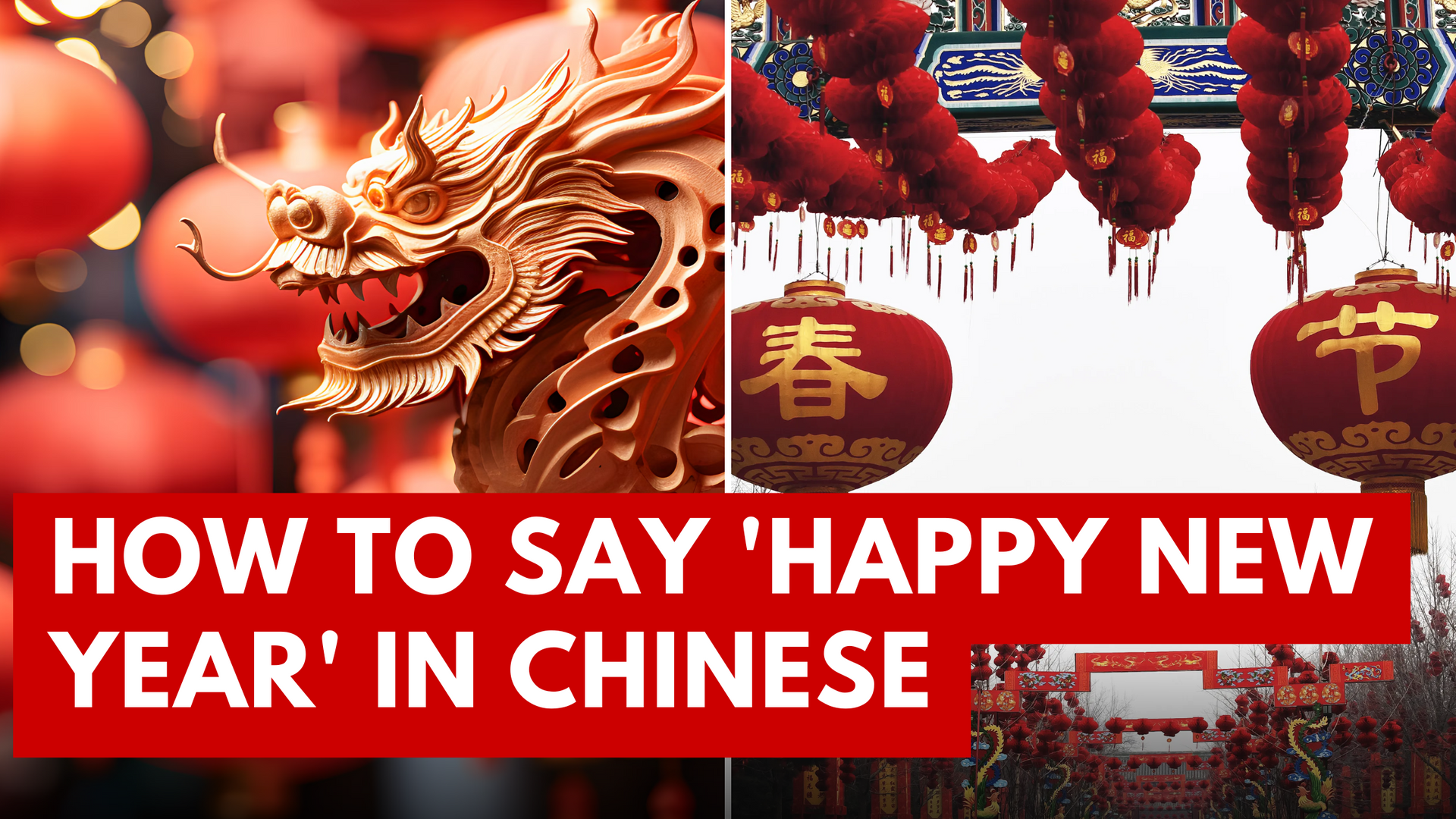Celebrating the New Year: How to Say 'Happy New Year' in Chinese and Its Cultural Significance

Introduction to Chinese New Year
The Chinese New Year , also known as the Lunar New Year, is a vibrant and deeply meaningful festival celebrated across the globe. Kicking off between January 21 and February 20, this 15-day event marks a new beginning on the Chinese lunisolar calendar. Rooted in legend and tradition, it’s not just a time for celebration but also for reflection and family bonding.
Family reunions are the heartbeat of the Spring Festival. Despite the challenges posed by recent global events, families strive to gather, share meals, and embrace each other’s company. Traditional dishes like sweet and sour fish symbolize abundance and growth, while sticky rice cake represents progress and togetherness.
The festival wouldn't be complete without its array of traditional greetings. Phrases like 新年快乐 (xīn nián kuài lè) and 恭喜发财 (gōng xǐ fā cái) are exchanged, carrying wishes of happiness and prosperity. These greetings, deeply embedded in the culture, reflect the hopes and aspirations for the year ahead, making them an essential part of the festive atmosphere.
Common Mandarin Greetings
The most prevalent way to extend New Year wishes in Mandarin is through the greeting Xīn Nián Kuài Lè (新年快乐), which translates to 'New Year Happiness.' This phrase is versatile, as it can be used for both the Lunar New Year and the Solar New Year on January 1st. Each character in this greeting carries its own meaning: 'Xīn' (新) means 'new,' 'Nián' (年) means 'year,' 'Kuài' (快) means 'fast' but implies 'happy,' and 'Lè' (乐) means 'happiness' or 'joy.' Together, they convey a heartfelt wish for happiness in the new year.
In mainland China, Taiwan, and Singapore, Xīn Nián Kuài Lè is a staple greeting during the New Year festivities. It is commonly exchanged among family, friends, and colleagues, often accompanied by the giving of red envelopes (hongbao) as a token of good luck. The use of this greeting underscores a broader cultural emphasis on renewal and togetherness during the Lunar New Year.
"These greetings are more than mere words; they are a way to share good fortune and happiness, connecting individuals with Chinese culture and its rich traditions."
This greeting, deeply rooted in tradition, signifies more than just a wish for happiness; it's a means to foster goodwill and strengthen social bonds. Such exchanges are vital in preserving the cultural heritage and values of the Chinese-speaking community.
Cantonese Variations
One of the most cherished greetings during the Chinese New Year is the Cantonese phrase Gung Hay Fat Choy (恭喜发财). Translating to 'Congratulations and best wishes for a prosperous New Year!', this greeting embodies the values of happiness and prosperity that are central to Cantonese culture. Its usage during the festive season is a reflection of the deep-rooted cultural emphasis on wealth and good fortune.
Cantonese is predominantly spoken in regions such as Guangdong Province, Guangxi, Hong Kong, and Macau. Each of these areas boasts a rich cultural heritage where Cantonese serves as a key linguistic and cultural identifier. Beyond China, Cantonese communities flourish in Southeast Asia, Europe, and North America, where the language plays a significant role in maintaining cultural traditions.
| Language |
Greeting |
Usage |
|---|---|---|
| Mandarin |
Xīn Nián Kuài Lè (新年快乐) |
Mainland China, Taiwan, Singapore |
| Cantonese |
Gung Hay Fat Choy (恭喜发财) |
Guangdong, Hong Kong, Macau |
The greeting Gung Hay Fat Choy is not only a wish for prosperity but also a nod to the cultural and social nuances that define Cantonese-speaking regions, highlighting the importance of language in cultural identity.
Modern Variations of Greetings
The landscape of Chinese New Year greetings is evolving, with younger generations crafting new expressions that blend tradition with modernity. One such emerging phrase is Xīn Nián Yǒu Lè (新年有乐), which translates to 'Happy New Year' and captures the joyous spirit of the Spring Festival.
Younger generations are adapting traditional phrases by infusing them with personal flair and modern expressions. This trend is partly driven by the rise of digital communication, where social media platforms play a significant role. During the Chinese New Year, using popular greetings can boost user engagement by over 190%.
-
Xīn Nián Yǒu Lè (新年有乐) - Happy New Year
-
Gōnghè xīnnián (恭贺新年) - A Happy New Year to you
-
Wànshì rúyì (万事如意) - Everything goes well
Digital greeting cards and personalized messages are becoming popular, encouraging unique phrases that resonate with individual preferences. This shift towards personalization reflects contemporary culture and personal expression, enriching the festive atmosphere with individualized well-wishes.
Customs and Traditions of Chinese New Year
As the Chinese New Year approaches, homes buzz with activity and anticipation. Families engage in the age-old custom of cleaning and decorating houses , sweeping away the past year's misfortunes and inviting prosperity. Red, a color synonymous with joy and good fortune, dominates the decorations, warding off evil spirits and symbolizing hope.
Central to the festivities is the family reunion dinner, a cherished tradition where loved ones gather on New Year's Eve. "The heart of Chinese New Year is family togetherness," a sentiment echoed across generations as they share a meal that strengthens bonds and honors their ancestors.
Adding to the vibrant atmosphere are the red envelopes (hóngbāo), filled with money and given as tokens of luck and well-wishes. This practice is steeped in cultural significance and extends across Chinese-speaking communities in Southeast Asia.
The festival's crescendo is marked by the dazzling spectacle of fireworks and lion dances. These performances are not only visually captivating but also believed to chase away evil spirits, ushering in a year filled with fortune and happiness. Thus, the Chinese New Year weaves together customs that celebrate renewal, prosperity, and the enduring power of family ties.
Cultural Significance of Greetings
In Chinese culture, greetings serve as more than mere words ; they are a vital means of demonstrating respect and fostering connections. This practice is deeply embedded in social etiquette, reflecting cultural values and norms.
-
**Importance**: Greetings are essential in initiating and maintaining guanxi (關係) , the intricate system of social networks and relationships. They signal respect and acknowledgment, crucial elements in both personal and community interactions.
-
**Strengthening Bonds**: The exchange of greetings often involves inquiries about one's well-being, demonstrating care and a sense of obligation. This reciprocal exchange not only fosters a sense of community but also strengthens social ties, reinforcing loyalty and obligation among friends and family.
-
**Language and Identity**: The Chinese language, with its rich historical legacy, plays a pivotal role in shaping cultural identity. Mandarin dialects reflect regional diversity and personal identity, while Chinese characters represent cultural values and historical continuity.
Thus, greetings in Chinese culture are not mere formalities but essential practices that cultivate and sustain social bonds, reflecting a deeper cultural identity that values respect, politeness, and relationship-building. These greetings, especially during the New Year, weave together the threads of cultural tradition and modern social interactions.
FAQs about Chinese New Year Greetings
Curious about how to express festive wishes during the Chinese New Year? Here are some common questions and answers to guide you:
-
What are the most popular Chinese New Year greetings? The widely used greeting in Mandarin is Xīn Nián Kuài Lè (新年快乐), meaning "Happy New Year." In Cantonese, people often say Gung Hay Fat Choy (恭喜发财), which translates to "Wishing you prosperity."
-
Are there differences in greetings across regions? Yes, regional differences exist. While Xīn Nián Kuài Lè is common in mainland China, Taiwan, and Singapore, Cantonese-speaking areas prefer Gung Hay Fat Choy. Understanding these nuances can enhance your cultural interactions.
-
How should I use these greetings appropriately? Respect is key. Always consider the relationship and setting when using greetings. For formal occasions, use traditional phrases and follow with wishes for health and happiness. Tone and body language, like a nod or smile, are crucial in conveying sincerity.
Embracing these greetings not only spreads joy but also deepens your connection to Chinese culture. Feel free to explore more on how greetings play a role in social interactions and cultural identity.
Conclusion
As we have explored, saying "Happy New Year" in Chinese is far more than a simple greeting. It embodies a wealth of cultural significance , reflecting the deep-rooted traditions and values of Chinese society. Whether expressed through Xīn Nián Kuài Lè in Mandarin or Gung Hay Fat Choy in Cantonese, these phrases carry wishes for prosperity, health, and happiness, fostering connections and respect within the community.
Embracing these greetings allows us to partake in the vibrant tapestry of Chinese culture. By sharing these expressions, we not only convey good wishes but also contribute to the preservation and appreciation of cultural identity. Such gestures are vital in today’s interconnected world, promoting understanding and goodwill across different communities.
Incorporating these greetings into your New Year celebrations is a small yet meaningful way to honor and appreciate Chinese culture. Let us continue to celebrate these traditions, recognizing their role in strengthening social bonds and showcasing the enduring beauty of cultural diversity. In doing so, we not only enrich our own experiences but also foster a deeper connection to the global community.
Limited Time Offer
Become a Successful NDIS Provider
$689 $349
Use code EARLY349 at checkout
News Feed







